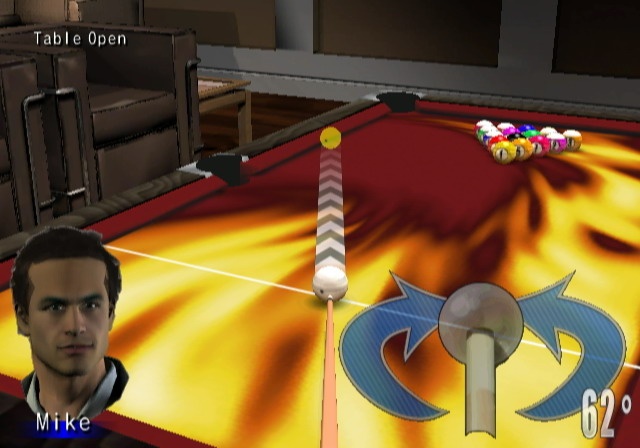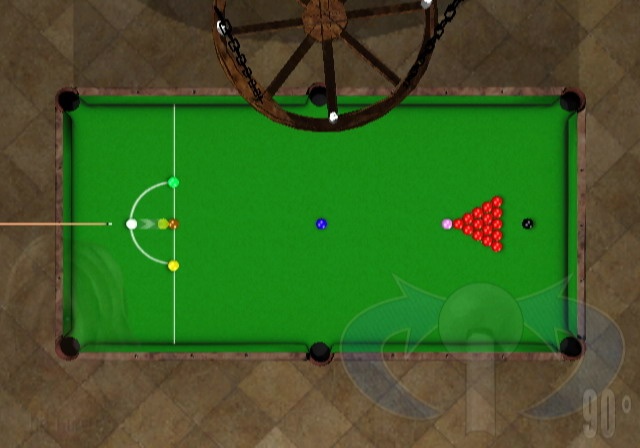The game of pool is fundamentally simple. Use a stick to hit a ball into other balls to make those balls fall into holes. It is a game played casually and competitively, in bars, basements, and pool halls. Pool Party presents a version of this popular table game that does a reasonable job of capturing the technical elements of pool while failing dismally to present these elements in an appealing way. No matter how much you enjoy 9-ball, snooker, or any of the other variations included herein, you'll find it hard to get past the bland artistic presentation, poorly tuned controls, and obtrusively unpleasant sound.
Pool Party offers a fairly straightforward bill of fare. Choose one of 13 different game modes that range from the traditional (9-ball, 8-ball, straight pool) to the exotic (blackjack (score 21 pts. to win), killer (3 misses and you're out)) to the British (full and short snooker). While deliberating over which mode to play, prepare for your first of many barbs of annoyance. An in-your-face upbeat jam repeats every 15 seconds, while a robotic woman's voice exhorts you to "select your game mode" every eight seconds. This is representative of the audio philosophy at work throughout the game, though, mercifully, the menus are the only place where you cannot mute the offending noise.

After selecting your game, it's off to the "Environment" selections, where you choose your venue, table, cue, ball set, character, music, and ball speed. Every one of these options is purely aesthetic and has no noticeable effect on the gameplay. This rule extends, disconcertingly, to ball speed as well. You can increase the available options by winning matches, but since there's no improvement from say, a nicer cue, you're essentially just unlocking new skins for the various elements.
Once you've made your selections you're transported to a table where the balls are racked and ready to go. You aim your cue by tilting the analog stick, or by pointing the remote while holding A. The analog stick makes small angle adjustments difficult, but a slight slip of the remote and you'll have spun around backward before you know it, so it's best to try a cautious combination of the two. You can change the vertical angle of your strike with the D pad and aim the cue at a specific point on the ball by holding the 1 button and pointing. Again, pointing is overly sensitive, so you'll likely find yourself using both hands to steady your aim. You set your power meter by holding B and using the analog stick, or by holding A and B and pushing the remote toward or away from the screen. The problem here is that shooting merely requires you to hold down B and make a slight forward motion with the remote, so it's easy for a small twitch of the wrist to trigger a premature shot. You can imagine the frustration when, after meticulously selecting the angle of a soft put-in shot, you misfire and send the cue ball rocketing around the table like an angry bee in a jar. A few such stings will make you more cautious, but this oversensitivity can make setting up and executing your shot feel like an exercise in tense precision, as if you were attempting a crazy trick shot on ESPN2 instead of playing a leisurely game.
This feeling of technical rigor might have been tempered were there adequate camera angles to allow you to eye your shot with some confidence. Unfortunately, of the six angles available, only two will be of any help. To imagine the useless four, you need merely picture yourself standing on one of the four sides of the table. You can look straight ahead, up, or down, but cannot turn your head at all. Instead, you can only strafe parallel to the table edge, back and forth as if on a rail, unable to focus your attention on the cue ball or any relevant sight lines. It won't take long before these views are merely something bothersome to toggle through on your way to the actually useful behind-the-cue and overhead views.
Once you've gotten a feel for the controls and have settled into your two functional viewpoints, playing a game can be pretty fun. Ball physics are represented fairly well, though they often feel a little tightly wound and unforgiving. This technical precision is fun when you're putting a lot of English on the ball to attempt some wacky shot, but can be frustrating when you're trying to keep it simple, which will be most of the time. The artificial intelligence will sometimes opt to miss an unfathomable shot rather than attempt an easy one, or will sink a few balls in a row in an incongruous burst of proficiency, but this irregularity averages out to be pretty fair competition.

Alas, it seems that twitchy controls and constraining cameras aren't enough to burden you with, so Pool Party throws in a few more unpleasantries to keep you dissatisfied. Superimposed at all times in the corners of the screen--and overlapping the table--are two images that each take up about 10 percent of the screen. One is a large image of your cue ball with angle notations that would only be helpful to Donald Duck in Mathmagic Land; the other is the invariably ugly CG visage of whatever character you have picked for the match. These obstructions are added to by the overhead lighting and other such structures that appear in certain venues to obscure your overhead view. Sound effects range from lame to jarring, and the background music is, with one or two exceptions, completely intolerable. When you inevitably go to turn it off in the menu (which you must awkwardly hold down the 2 button to access), you may be tempted by the option "SOUND," located between "MUSIC" and "OFF." This is essentially ambient noise which, depending on your venue, may include phones ringing, birds chirping, eerie spook-out atmospheric tones, or a man yelling in a foreign language into a bullhorn. You should really just go with "OFF."
While the technical sharpness of Pool Party can make for some entertaining moments, the wealth of indignities presented here makes for a pretty unappealing package. The purest fun to be had might just be in the practice mode, which allows you to place any ball anywhere and set up some pretty satisfying trick shots. If you are intrigued by such feats, then steel yourself against irritation and give this game a rent. All others are advised to seek their pool fix elsewhere.